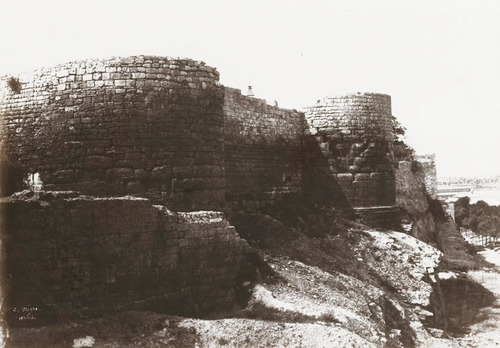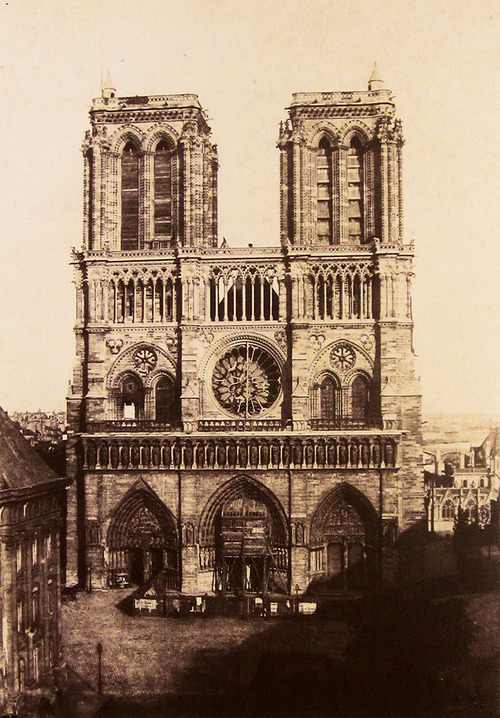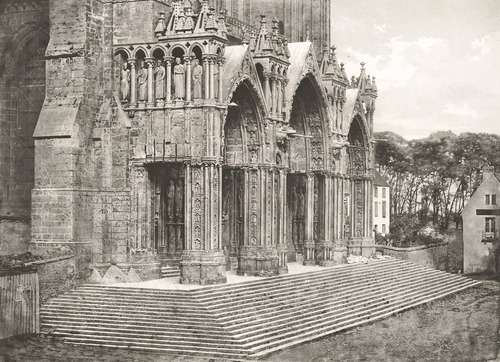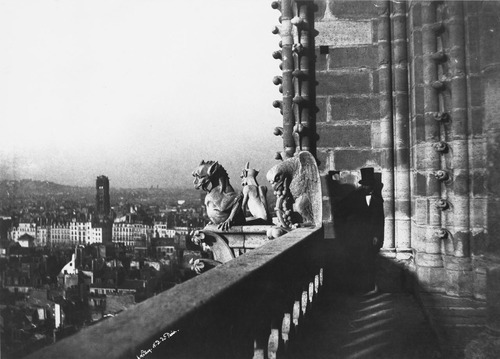After studying the place occupied by Charles Nègre in the history of street photography, today we chose to study hiswork with architectural
photography.
As we said it on Monday, Charles Nègre isn’t chosento participate to the Mission Héliographiquein 1851. The goal of this mission is to document French architecture.
Nevertheless, Charles Nègre decides, in 1852, to do a coverage of the
south-east French architecture.
With this first
photographic sequence we can see the beginning of a geometric
presentation and of an abstraction that will become clearer in one of his
most-known photographies, Le Stryge.

Les rempart d’Arles (1852), épreuve sur papier
salé d’après un négatif papier, 23X33 cm, Collection
Privée.
This view of the Arles ramparts taken during his stay
in the Midi Region, doesn’t
have, at first sight, any documentary interest. However we can
observe that Charles Nègre technique is already undeniably striking.
The image details have kept all their precision in low lights.
Moreover, the massive position of the two towers, and the diagonal
created by the ramparts guide our look towards the hinterland and
contribute to a sense of balance. Finally, the important contrast
between the burned part of the sky and the darkest areas of the wall
immersed in the shadows create a chiaroscuro
that is almost disturbing. If the final result of this photography is
mainly due to the extreme sensibility of the process used at the blue
light of the sky, this particularity is used by Charles Nègre in
order to give more strength to his image.
We can find the same
process in this interior view of the ramparts.

Arles, vue intérieur des remparts, côté
sud, (1852), épreuve sur papier salé d’après un négatif
papier, 24,5X33 cm, Collection Privée.
Here, Charles Nègre works with a chiaroscuro
between right and left of the image. We can guess at the background
the city of Arles. The photography gives a lot of details in its dark
parts. The representation that Charles Nègre gives us is the one of
a ruined, natural and non-living arenas. The necessity of the
documentary he realises in the region is evident as we see the
historic importance of the monuments photographed. The photographer
not only uses an irreproachable technique but he choses a framing and
depth of field that places the monument in the city and in History.
The clarity of the city on the back ground is in contrast with the
darker parts of foreground. We can feel in this photography a
willingness of geometric presentation : the circle drawn on the
dirt remind us the ramparts curve and the arcs that spine the damaged
structure.

Vue de la Cathédrale Notre Dame de Paris,
(1853), épreuve sur papier salé d’après un négatif papier,
24,5X33 cm, Collection privée.
This photography shows us the Cathedral in the time
where the pediments of the facade were under construction according
to the Violet-le-Duc plans. It is a testimony of the building
renovation as we know it.
Charles Nègre choice of framing required a certain
preparation. He positioned himself at a higher point, certainly
acceding to a balcony in order to take this picture. The photography
doesn’t lack of depth and we can see on both sides, the city of Paris
expanding over the horizon. Once again, there is a strong contrast
between the sky, alway burned, and the darkness of the lower part of
the image. As if the cathedral were rising towards the light. Charles
Nègre controls both the framing and the contrast in order to
translate the monumental aspect of this cathedral. Yet, this frontal
image doesn’t show the depth of the monument and makes it seem as if
it was a stage setting.

Porche Sud de la Cathédrale de Chartres (1857),
Héliogravure, 53X71cm MoMA.
Recognise for his photographic talents and his
capacity to catch the essence of the places he photographies, Charles
Nègre is asked to realise a sequence of photographies of the
Chartres Cathedral in 1857. The particularity of these photographies
is that they were realised according to the process of damasquinure
héliographique, a technique that was invented by Charles Nègre himself.
This process allows to preserve a maximum of details in both highest and
lowest lights. The stairs going up to the cathedral guide our look
toward the pillars and the porch. Thanks to this process, Charles
Nègre manages to control the exposition allowing him to catch
perfectly every detail of the structure darker than the sky. He also
manages to preserve a quality of the high lights, allowing us to
distinguished very clearly the clouds. Here again, we found ourselves
in front of a chiaroscuro with
a clearer geometric presentation.

Le Stryge, 1853, épreuve sur papier salé
à partir d’un négatif papier ciré sec
32,5X23 cm, Musée
d’Orsay.
Le Styrge, is the name given to this
photography by the collector André Jammes as an analogy to an
engraving of the paintor Charles Méryon. It is one of the most-known
masterpieces of Charles Nègre. This photography was taken on the
rooftop of Notre-Dame and shows his friend Henri Le Secq, framed
between two gargoyles. The character contemplate Paris dressed
casually and wearing a top hat. The mouldings of the building where
he stands are very detailed.
The geometrisatic presentation and abstraction work
is here obvious. The diagonal of the barricades, the horizontal wall
and the two sculptures enlivened by this clever production make of
this photography a masterpiece.

Charles Nègre à Notre-Dame de Paris, 1853,
épreuve sur papier salé à partir d’un négatif papier ciré
sec, Paris, Bibliothèque des arts décoratifs, Médiathèque de
l’architecture & du patrimoine.
This last photography taken by Le Secq, can bring a
parallel to the work done with the Stryge. Here, the atmosphere is
completely different. Charles Nègre is hidden in the shadows and is
only visible for his white collar. This gives a disturbing feeling
and remind us of Victor Hugo Notre-Dame de Paris published
twenty years before. If this photography is interesting by the
production, it does not capture the observer by its work of geometry,
but reminds us of Charles Nègre work on street photography.
